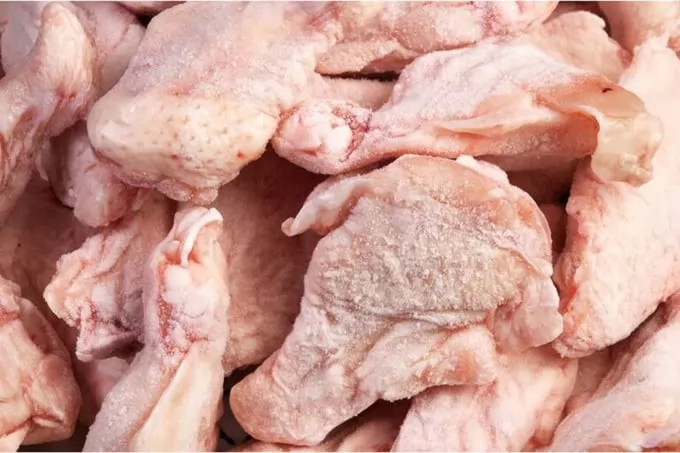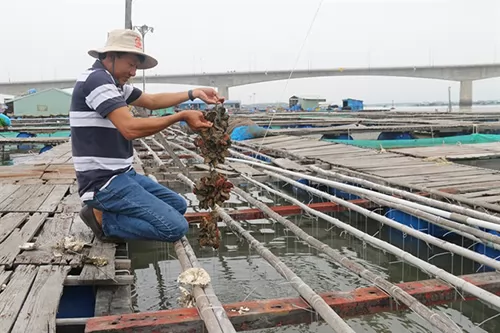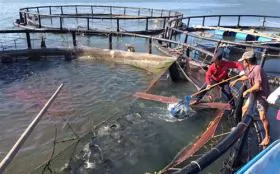Farmers profit from breeding crabs amid mangroves

Farmer Lê Minh Khánh shows his mangrove crabs that he bred in the protective mangrove forest area assigned to him in An Biên District’s Nam Thái Commune in Kiên Giang Province. – VNA/VNS Photo Lê Sen
Viet Nam News / KIÊN GIANG – Kiên Giang Province’s Farmers Association plans to expand the breeding of ba khía (Sesarma mederi), a mangrove crab species, in protective mangrove forests in An Biên District.
In early 2017, the association started the model in the district’s Nam Thái Commune after many of the households suffered losses from raising black tiger shrimp, fish and other kinds of crabs in mangrove forests which they were assigned to protect and harvest products.
Lê Minh Kháng, who was allocated 8ha of protective forestry land in Nam Thái in 1992, said after receiving the land, he used 70 per cent of the area to grow mangrove forests and the rest to breed black tiger shrimp, crabs and fish.
In the first years, mangrove trees were small and water resources were clean, yielding profits from black tiger shrimp, crabs and fish.
However, mangrove trees are now bigger and their fallen leaves pollute water resources, affecting the breeding of the aquatic species in the mangrove forest, according to Kháng.
Similarly, many households in the commune have suffered losses from breeding the aquatic species in mangrove forests and have switched to other jobs such as fishing near shore or working for daily hire.
Under the support of the association, households chosen to breed the mangrove crab on a pilot basis were given VNĐ14.4 million (US$620) for breeding the mangrove crab on an area of one hectare and above.
The initial cost of breeding the mangrove crab is about VNĐ40 million ($1,720) per hectare. The money was used to buy breed crabs, nets and stakes to fence the breeding area, and other materials for breeding the mangrove crab.
The pilot breeding showed that the mangrove crabs adapted to the forest environment, had a survival rate of more than 50 per cent, and reached an average weight of 30 -35 crabs a kilo after six months of breeding, according to the association.
The pilot programme helps protect the ecological system and mangrove forests.
Khánh was one of the farmers who began breeding the mangrove crab on his eight-hectare mangrove forest area in early 2017. He released 250 kilos of the mangrove breed crabs into a one-hectare breeding area.
He earned VNĐ60 million ($2,580) from selling the mangrove crabs he has harvested, about 15 – 20 kilos a night every three to four days.
Traders buy the crab for VNĐ50,000 ($2.1) a kilo. Demand now exceeds supply.
After the harvest season, which is between lunar August and February, Khánh plans to continue breeding the crab and will expand the breeding area.
Phạm Minh Phận, deputy chairman of the Nam Thái Commune Farmers Association, said: “The model has proved effective and offered one more aquatic species for breeding in mangrove forests.”
"The model supplies quality product to the market and creates jobs for locals," he said.
The Nam Thái Commune Farmers Association has encouraged farmers to expand the model to improve their income.
The mangrove crab is easy to breed, eats natural food and is less susceptible to disease. It is bred at a density of 20 crabs per square metre.
The mangrove crab digs holes and lives in them during the day and crawls out of the hole at night to stay on the ground or climbs on roots and branches of mangrove trees to eat food.
In recent years, the number of mangrove crabs in the wild has fallen dramatically in the Mekong Delta. It is used in many dishes, especially fermented mangrove crab, a specialty in the delta. – VNS
Maybe you are interested

US poultry exports to central Asia is in jeopardy
Russia mulls banning US poultry transit through its territory, citing concerns over highly pathogenic avian influenza. The move would hurt the US broiler meat export to central Asia.

Bà Rịa – Vũng Tàu farmers breed Pacific oysters
Viet Nam News / BÀ RỊA-VŨNG TÀU — Many farmers in the southern province of Bà Rịa – Vũng Tàu are breeding Pacific oysters since they have a high survival rate and steady demand in the market.

Farmers use Farmers use advanced techniques to breed fish in cages
VietNamNet Bridge – Farmers who breed marine fish in floating cages in Vung Tau City in the southern province of Ba Ria-Vung Tau are using new advanced farming techniques with good results.





